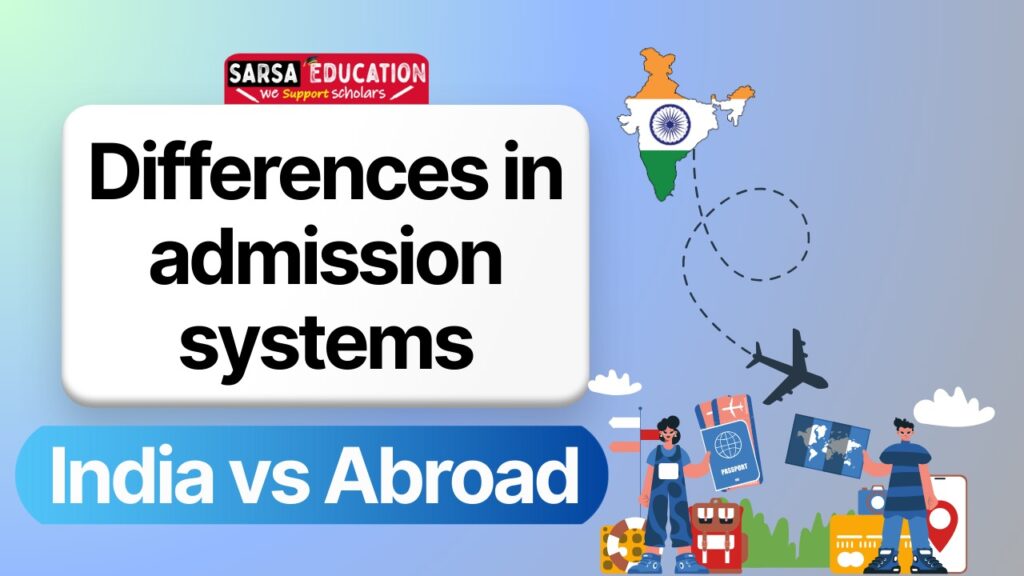Differences in Admission systems can play a huge role in shaping student’s future, especially when deciding between studying in India or abroad. While both paths offer quality education, the way students are selected for universities in these regions is vastly different. Indian institutions mostly rely on competitive entrance exams and academic performance. On the other hand, international universities often evaluate students using a holistic approach considering their personality, extracurriculars, essays, and more.
Understanding these differences in admission systems is crucial for students and parents planning for higher education. In this article, we’ll explore how admissions in India differ from those in countries like the USA,UK, Canada, and Australia, and what each system expects from an applicant.
Key Differences in Admission Systems (India vs Abroad) – Differences in Admission Systems: India vs Abroad
Let’s dive deep into the key differences in admission systems between Indian and foreign universities:
1.Entrance Exams vs Holistic Review
India:
Admissions heavily rely on entrance exams like JEE, NEET, CUET, and others. A single test score can determine your entire future.
Abroad:
Most foreign universities follow a holistic admission process. Along with academics, they consider:
- Personal statements
- Letters of recommendation
- Extracurriculars
- Standardized tests (like SAT, GRE), if required
2. Academic Focus vs Well-Rounded Profile
India:
High marks in board exams and entrance tests are often the sole criteria.
Abroad:
Universities abroad value a well-rounded candidate. Volunteering, leadership roles, and creative pursuits all add value to your application.
3. Timeline and Flexibility
India:
Admissions start after board results, and the entire process wraps up quickly, mostly within May–August.
Abroad:
Applications are submitted 6–12 months in advance. Options include early decision, early action, and regular admission rounds.
4. Application Portals
India:
Most colleges have their own portals or centralized systems like JoSAA, CUET, or state-level counseling platforms.
Abroad:
Foreign universities often use centralized application systems:
- Common App (USA)
- UCAS (UK)
- OUAC (Canada)
These platforms simplify the process by letting you apply to multiple universities at once.
5. Use of Standardized Tests
India:
Standardized entrance exams are mandatory and specific to each field (e.g., JEE, NEET, CLAT).
Abroad:
Some universities ask for SAT, ACT, GRE, or GMAT. However, many institutions have gone test-optional post-pandemic.
6. Personal Statement or Essay
India:
Rarely required. Few private colleges may ask for a Statement of Purpose (SOP) during PG admissions.
Abroad:
Essays and SOPs are crucial. They give insight into your goals, personality, and passion.
7. Interviews
India:
Interviews are limited to MBA, design, or other niche programs.
Abroad:
Interviews (online or in-person) are common, especially in Ivy League schools, top UK universities, and graduate programs.
8. Reservation vs Merit-Based Diversity
India:
Reservation systems based on caste, region, and other categories play a major role.
Abroad:
Diversity is encouraged through need-based aid, international quotas, and inclusive policies, not rigid reservation systems.
9. Documentation Required
India:
- Exam scores
- Board marks
- Caste certificate (if applicable)
- Identity proof
Abroad:
- Academic transcripts
- Language proficiency test (IELTS, TOEFL)
- LORs
- SOP
- Portfolio (for arts/design)
- Passport and visa documents
10. Tuition Fee and Financial Aid
India:
Public colleges are affordable. Scholarships are limited and often merit/reservation-based.
Abroad:
Tuition can be high, but scholarships, grants, and financial aid packages are available, even for international students.
Related links:
- Benefits of Online MBA
- MBBS Abroad with Scholarships
- Study in Germany for free for Indian Students
- Masters in UK Fully Funded
Frequently Asked Questions (FAQs):
1. What are the key differences in admission systems between India and abroad?
The key differences in admission systems between India and abroad include entrance-based admission in India vs. holistic evaluation abroad. Indian universities often rely heavily on competitive exams like JEE, NEET, or CUET, while international institutions consider academics, extracurriculars, essays, and recommendations alongside test scores.
2. How does the role of entrance exams differ in India and abroad?
In India, entrance exams are usually the primary criteria for most professional courses. Abroad, especially in the US and parts of Europe, entrance exams like SAT or ACT are just one part of the application, and many universities are moving towards test-optional policies. This marks one of the major differences in admission systems globally.
3. Are school grades more important abroad than in India?
Yes, in many countries abroad, consistent academic performance across school years is crucial. In contrast, India often emphasizes final board results or entrance test scores. This showcases one of the differences in admission systems, where Indian systems may undervalue long-term academic consistency.
4. What role do personal essays play in foreign admissions?
Personal essays are a vital part of admissions abroad, especially in countries like the US, UK, and Canada. These essays reflect a student’s personality, aspirations, and fit with the university, whereas Indian systems generally don’t consider essays. This is a stark difference in admission systems.
5. Do Indian universities require letters of recommendation?
Typically, Indian universities do not require recommendation letters for undergraduate admissions. However, foreign universities often need one or more recommendations from teachers or mentors. This reflects the broader differences in admission systems concerning applicant evaluation.
6. How do extracurricular activities impact admissions abroad compared to India?
Extracurriculars carry significant weight abroad. Admissions committees abroad assess leadership, creativity, and initiative beyond academics. In India, these are rarely considered, highlighting crucial differences in admission systems.
7. Are interviews a part of the admission process in both systems?
Interviews are rarely used in Indian undergraduate admissions except in select private or international schools. Abroad, interviews (especially for competitive programs or scholarships) are more common, adding another layer to the differences in admission systems.
8. What is the difference in application timelines between India and abroad?
Indian admissions typically occur right after board results or entrance exams. Abroad, applications often begin months before the academic year, with deadlines in December–January for fall intakes. This timing gap is a noticeable difference in admission systems.
9. Is it easier to get financial aid abroad than in India?
Many international universities offer merit-based or need-based financial aid. Indian universities offer limited scholarships, often based solely on academic or entrance exam performance. This again highlights differences in admission systems, particularly in accessibility and equity.
10. How are students evaluated differently during admissions?
Indian admissions primarily focus on marks or ranks. Abroad, evaluation is more holistic, considering academics, personality, social contribution, and potential. This comprehensive evaluation approach demonstrates clear differences in admission systems.
11. What platforms are used for applications abroad vs. in India?
In India, students apply directly to individual universities or through central portals like CUET or JoSAA. Abroad, systems like Common App (US), UCAS (UK), or OUAC (Canada) allow centralized applications. These platforms reflect operational differences in admission systems.
12. Do international universities look at 10th-grade marks?
Yes, many foreign universities evaluate grades from 9th to 12th. In India, 12th-grade board marks or entrance scores dominate the process. This difference in evaluating academic history is part of the differences in admission systems.
13. How important are standardized tests like SAT or ACT?
Abroad, these tests were traditionally important but are now becoming optional at many universities. India, on the other hand, still depends heavily on standardized testing for most admissions, underlining fundamental differences in admission systems.
14. Can Indian students apply to foreign universities without entrance exams?
Yes, many universities abroad allow applications without standardized tests, especially with strong academic records and profiles. This flexibility is one of the biggest differences in admission systems that benefits students aiming for diverse opportunities.
15. How do Indian and foreign systems differ in selecting students for professional courses?
Professional courses like engineering and medicine in India are almost entirely entrance-exam based. Abroad, students often enter general undergraduate programs and specialize later. This delayed specialization is a structural difference in admission systems.
16. Are admissions abroad more competitive than in India?
It depends on the university. Elite schools abroad are very competitive, but mid-tier ones offer good chances with strong profiles. Indian admissions are extremely competitive for top government colleges, mainly due to population pressure—highlighting different kinds of competitiveness in admission systems.
17. Is English proficiency testing required abroad?
Yes, tests like IELTS, TOEFL, or Duolingo are often required abroad. In India, such tests aren’t needed unless applying to an international program, marking a procedural difference in admission systems.
18. How flexible are foreign admission systems compared to India’s?
Foreign systems often offer flexible admissions with multiple intakes and transfer options. India generally sticks to rigid, single-cycle admissions. This adaptability marks a key difference in admission systems.
19. What role do subject choices in school play in admissions?
Abroad, subject choice alignment with intended majors is crucial. Indian colleges are more flexible unless it’s for specialized courses. This selective subject importance is another difference in admission systems.
20. Are gap years accepted abroad and in India?
Gap years are commonly accepted abroad, often even appreciated if used constructively. In India, gap years are still viewed skeptically unless justified for entrance prep. This contrast adds to the differences in admission systems culturally and academically.
21. Can one apply to multiple courses in the same university abroad?
Yes, many foreign universities allow this flexibility. Indian systems are stricter, often requiring one course per application. This institutional policy reflects differences in admission systems in terms of student choice.
22. How do universities abroad verify academic records?
Abroad, transcripts must be official and often need third-party evaluation (e.g., WES). In India, verification is done via board results or entrance scores. The verification process showcases administrative differences in admission systems.
23. What’s the difference in postgraduate admission systems?
India’s PG admissions are again mostly entrance-based. Abroad, PG admissions emphasize SOPs, references, and work experience more than just tests. These evaluation metrics highlight differences in admission systems at advanced levels.
24. Are admissions more decentralized abroad compared to India?
Yes. Abroad, universities have autonomy in setting their admission criteria. In India, centralized systems like JoSAA or CUET regulate admission for many public institutions, indicating systemic differences in admission systems.
25. How do students prepare differently for admissions in India and abroad?
Indian students often focus intensely on coaching for entrance exams. Abroad, students prepare over years by building profiles, portfolios, and holistic achievements. This contrast in preparation reflects deep-rooted differences in admission systems.
For National/International Scholarship updates kindly join our WhatsApp channel
Follow the Sarsa Education channel on WhatsApp: https://whatsapp.com/channel/0029VaL9SgRAjPXJthnK9D0E
In case of any queries, please reach out to:
+91-9156405182 (Monday to Friday – 10:00 AM to 06:00 PM (IST))
For regular Scholarship/Fellowship/Internship updates:
Join our Telegram channel: Sarsa Education







